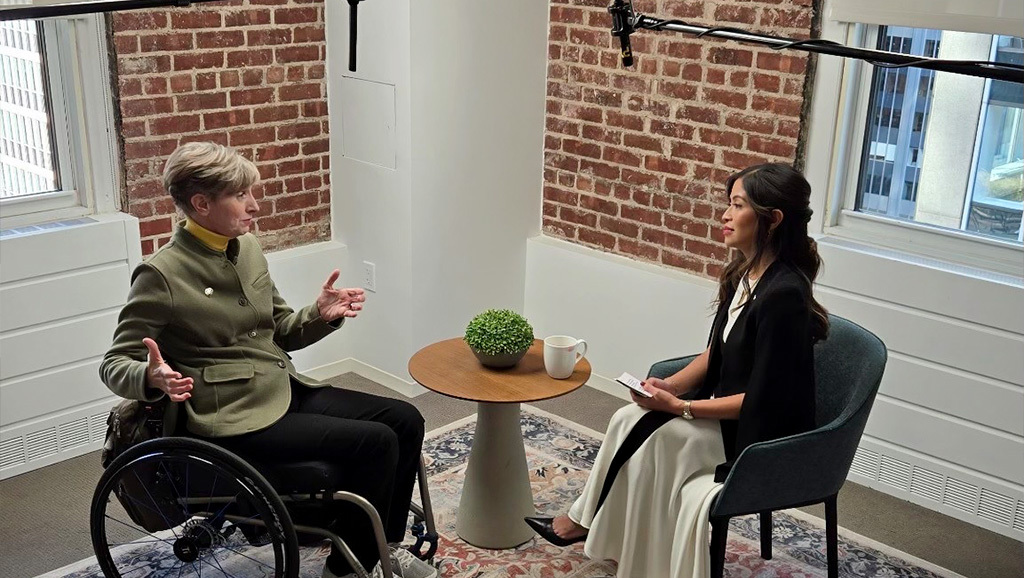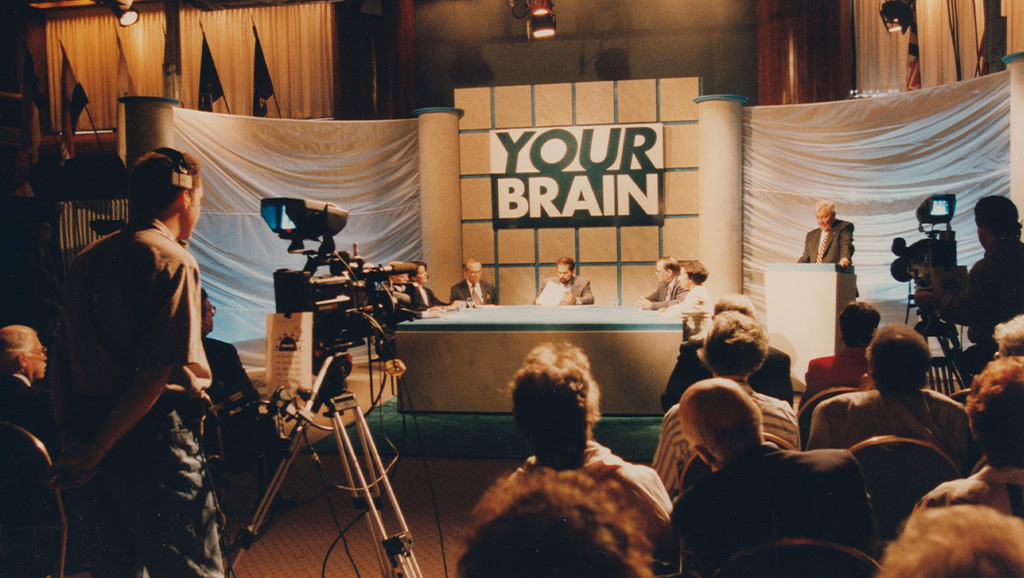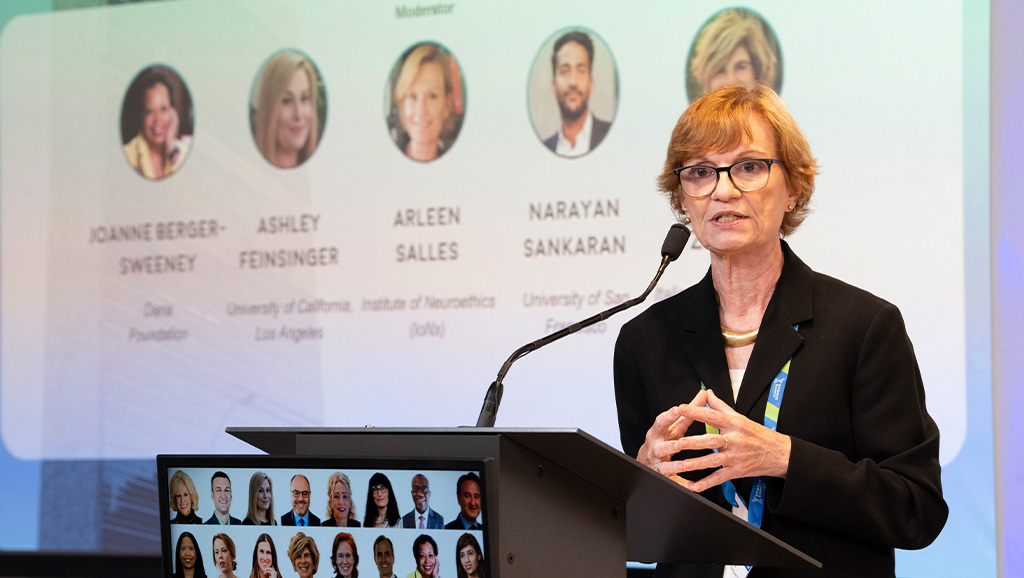Impact Story
Navigating the Future of Brain-Computer Interface Technology
A conversation with Jennifer French


With groundbreaking technologies promising the potential to transform lives, neuroscience and society are growing increasingly entwined. Neurotechnology, for the lay audience, may conjure images of virtual reality systems or implantable chips as seen in movies or read in science fiction novels, while in fact, it’s an established field that holds great potential for improving the lives of individuals with neurological conditions. But despite nearly 50 years of work, critical questions around clinical research, development, and access continue to emerge.
In our latest episode of NeuroSociety Stories, Dana Foundation President Caroline Montojo interviews Jennifer French, a trailblazer in the field of neurotechnology. French has lived with an implanted neuroprosthesis for the last 25 years, witnessing firsthand the successes and copious failures when it comes to new devices on the market. As a Paralympian, advocate, and executive director of the Neurotech Network, she shares her insights on the evolving neurotech landscape and the vital role of community engagement and patient perspectives.
“Community engagement is not just helping developers understand the medical process and how people interact with the healthcare system, whether they’re affluent, underprivileged, or living in rural areas,” French says. “It’s also about understanding how they interact socially and within their communities—their norms, values, and beliefs.”
French also sheds light on systemic challenges in the field and stresses the need for collaborative efforts to bridge this divide. Last year, with support from the Dana Foundation and together with neurologist Leigh Hochberg and pathologist Joe Lennerz, French created the Implantable Brain-Computer Interface Collaborative Community (iBCI-CC) to encourage the cross-sector relationships needed to overcome development hurdles.
The conversation between Montojo and French underscores a crucial shift in neuroscience: the growing emphasis on collaboration and inclusivity. By integrating community voices into the research process, the field can move beyond the lab and deliver tangible benefits to society. This approach not only enhances the quality of life for individuals with neurological conditions but also strengthens the societal impact of neuroscience as a discipline.
Watch the full interview below or on our YouTube along with previous episodes.
TRANSCRIPT
(Intro music)
CAROLINE MONTOJO, HOST: Jen, welcome to the Dana Foundation. It’s great to have you here. Welcome.
JENNIFER FRENCH: Great to be here. Thank you.
MONTOJO: Hello, and welcome to NeuroSociety Stories. This series is all about having meaningful conversations and sharing stories to show the great potential of neuroscience in society. I’m Caroline Montojo, President and CEO of the Dana Foundation, where our mission is to advance neuroscience that benefits society and reflects the aspirations of all people.
Today, I am honored to be joined by our special guest who is an accomplished athlete, author, advocate, and champion for neurotechnology through her own lived experience. I’d like to welcome Jennifer French, who is the Founder and Executive Director of the Neurotech Network. It’s a nonprofit focused on bringing the benefits of neurotechnology devices, therapies, and treatments to people living with neurological conditions.
She won a silver medal in sailing for Team USA in the 2012 Paralympic Games in London, and she’s Co-Founder of Warrior Sailing, a program for wounded, ill, and injured service members and veterans to develop maritime skills and build partnerships with marine communities. And most recently, Jen was awarded the 2024 Craig H. Neilsen Visionary Prize, which honors those whose innovative work and dedication have significantly improved the quality of life for people living with spinal cord injury.
Wow. Jen, welcome.
FRENCH: Thanks, Caroline. It’s great to be here. It’s great to have you.
MONTOJO: I think, just to get us started, I’d love to hear a bit about your own story. You’ve always been an athlete, and I’m curious how you were introduced to neurotechnology.
FRENCH: I was not always a competitive athlete. I was more of an outdoor athlete, so outdoor sports were my thing. When I had my spinal cord injury from a snowboarding accident 26 years ago, that’s when I got thrown into this world of disability. And even before my injury and even after my injury, I was in the consumer technology business. So I understood technology.
After my injury, when I’m told that there’s no cure for spinal cord injury, I started to look at what are the alternative treatments, and I didn’t understand the biologics and some of the chemical treatments. Those were foreign to me and, in some ways, scary. But I understood technology, and that was my introduction to things like electrical stimulation for rehabilitation and a lot of other methods. That’s what drove me to find a clinical trial in Cleveland where I became a participant of an implanted neuroprosthesis that allows me to stand and transfer and use it for other functions.
One of my “Aha” moments was at a neural interfaces meeting on the NIH campus when I was sitting on a panel with people with a variety of neurological conditions—from hearing impairments to Parkinson’s disease to other forms of paralysis—and we all had the same issues. We all had, “How do we find this technology? It’s very difficult to understand, and how do we build an understanding within the community so that people can access the technology?”
MONTOJO: Jen, you bring such a unique perspective living with an implanted device. In your view, can you share with us why you feel it’s important for patient perspectives and values to be included in the research development process with neurotechnologies?
FRENCH: Yeah, absolutely. This is my 25th year of living with an implanted neuroprosthesis, and over those 25 years, I’ve seen the development of some fantastic technologies that have done some great things in the lab but have failed in the marketplace. And why is that? One thing that we have to learn about implanted devices is they are inherently personal. They’re inherently interactive, and they are solving very complex neurological conditions that most other treatments can’t address.
So, we have this area called the “Valley of Death,” and it is fraught with innovative technologies. Those technologies have failed for a variety of systemic reasons. But there are inherent ways that we can help those technologies move along. One of them, that at least I see, that we are really starting to pinpoint is community engagement.
Community engagement is not just helping developers understand the medical process and how people interact with the healthcare system, whether they’re affluent, underprivileged, or living in rural areas. It’s also about understanding how they interact socially and within their communities—their norms, values, and beliefs.
So it’s not just training the developers but making sure that we have that interaction between the community and people who are developing the technology so we can build the next generation in a smart manner.
MONTOJO: I’m just curious, maybe from a side perspective, did you expect that neurotechnology would be where it’s at today, or has it exceeded your expectations?
FRENCH: I have seen huge acceleration with the help of the BRAIN Initiative. The investments made in the BRAIN Initiative have had a significant impact on this entire industry, whether it’s from the developmental side or the commercial and investment side. I think the public investment in neurotechnology is really important.
This is an emerging technology and field, and how do we help marshal that? How do we help people living with neurological conditions connect to the technology that is becoming available as potential treatments for them? We’re at a point where we have investors coming in, but there are still systemic challenges that need to be solved.
MONTOJO: Yeah, I appreciate that, Jen. Thank you for sharing that perspective about the BRAIN Initiative and how it provided such a stimulus for the development of neurotechnology.
FRENCH: It was. It was a shot that the industry needed.
MONTOJO: The Dana Foundation has worked with you closely to establish something called the Implantable Brain-Computer Interface Collaborative Community—long name. We can call it iBCI-CC as well. What inspired you to form a collaborative community around this topic?
FRENCH: The iBCI-CC is really at the intersection of neuroscience and society. We in society define implantable brain-computer interfaces in a lot of different ways, but the way that we define it within the collaborative community is that it needs to have three elements:
One, it needs to be a device implanted under the scalp or in the cranial space via a variety of methods. Two, it needs to be able to sense activity of the brain and interpret that activity, typically through software. And three, it needs to use that activity to enable restoration or rehabilitation, empowering users to have a more independent quality of life.
What inspired us to start this? My collaborators Leigh Hochberg and Joe Lennerz and I came together and saw key elements where a collaborative community might be able to help.
We are at a pivotal moment for implantable brain-computer interfaces, moving from first-in-human and safety studies to larger studies and making the devices available on the market. The industry is ready to marshal this technology, but they face challenges that cannot be solved by industry or research alone. They require a collective effort from diverse stakeholders—industry, research enterprises, regulators, payers, hospital systems, clinical communities, and importantly, the patient advocacy organizations, care partners, and individuals with lived experience.
MONTOJO: It’s so interesting to hear about the diversity of stakeholders in this group and how that can overcome some of the challenges you mentioned earlier, like the “Valley of Death” that many brain technologies face.
What do you hope the Implantable Brain-Computer Interface Collaborative Community will achieve? And I know it’s still early days, but could you share some early outcomes so far?
FRENCH: The support from the Dana Foundation has been pivotal. Before launching the iBCI-CC, we focused on accelerating development, improving safety and efficacy evaluation, and enhancing access to ensure independence and quality of life for individuals.
Since our first charter meeting in January, we’ve made significant strides. We had 17 signatory organizations sign on as founding members, half of which were patient advocacy organizations. We received our federal liaison letter, allowing federal agencies to collaborate with us. In March, we officially launched the Collaborative Community and spent time intentionally listening to diverse community perspectives to identify challenges.
We’ve organized our operations through seven work groups, each focused on specific topics like clinical outcome measures, ethics and data security, interoperability, user priorities, and public engagement. For example, our clinical endpoints work group has developed a comprehensive list of potential clinical outcome measures for implantable brain-computer interfaces. This list is now being harmonized, and we aim to create a menu of outcome measures that can be utilized by industry, researchers, and regulators. Despite being young, we now have nearly 350 members and hosted our first public meeting in September.
MONTOJO: Those sound like major steps forward, especially developing the first comprehensive clinical outcomes rubric for this field. Congratulations on those achievements.
FRENCH: Thank you. We have an incredible team.
MONTOJO: Jen, what do you think funders of neurotechnology should know? Do you have recommendations for those funding or developing neurotechnologies?
FRENCH: We’ve made incredible progress with the support of funders. For example, initiatives like the BRAIN Initiative and foundations like the Dana Foundation have helped us learn a lot about the human brain and nervous system and build prototypes for solving complex neurological conditions. But the neurotech industry is young and fragile.
There are critical gaps, and funders can help in several ways. First, help bridge the “Valley of Death” by supporting the transition from small clinical trials to larger trials and clinical adoption. Second, encourage innovators to design technologies with translation in mind, rather than just building proof-of-concept prototypes. Third, assist in developing clinical pathways to ensure these technologies are accessible to all communities, including rural areas. Finally, drive community engagement by involving potential end-users and the public to ensure technologies meet their needs.
MONTOJO: Jen, thank you so much for joining us today. It was inspiring to hear your story and learn how you’re building a community around neurotechnology to maximize its societal benefits. Thank you for your efforts and those of your collaborators.
FRENCH: Thank you for the opportunity and for the support from the Dana Foundation and all our collaborators.


